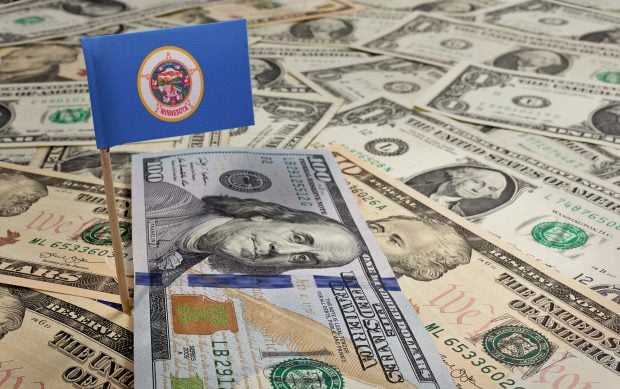ALEXANDRIA, Va.- Last quarter, April 1 through June 30, bankruptcy filings rose 24.5% over the same period last year, making it the highest quarterly period ever for bankruptcies, according to data by the Administrative Office of the U.S. Courts. Filings increased from 321,729 in the second quarter of 2000 to 400,394 during the same period this year. Bankruptcy filings are now in line to break the former 1998 record year when nearly 1.5 million new cases were filed. Through the first half of 2001, 767,235 cases have been filed. American Bankruptcy Institute (ABI) Executive Director Samuel J. Gerdano called the figures "alarming, if not shocking." Not so for the credit union community. While many in the financial services industry are preparing for hard times ahead, credit unions are expected to fair better than most. "Although we're seeing an upward trend in credit unions, we don't think it's going to be a problem for most credit unions," NAFCU Economist Jeff Taylor said. He remarked that, in general, credit unions are able to make better character assessments of their borrowers than large banks, which helps to shield them from bankruptcy abuse cases. Generally, credit unions also hold a smaller percentage of unsecured loans than banks. CUNA Chief Economist Bill Hampel attributed the increase in bankruptcy filings during the first half of the year to an "artificial effect of expected passage of the bankruptcy reform act H.R. 333/S. 420," which would make filing for bankruptcy more difficult. He explained, "If you are in the margin or you feel you may be a marginal case or your lawyer convinces you [that] you are.you think, `we better file now'. " There have been several reports of bankruptcy lawyers under the gun to drum up business under the current bankruptcy system. When Congress returns from the August recess, bankruptcy reform conferees are expected to settle down to work on two sticking points in the legislation between the Republican controlled House and the Democratic controlled Senate: the level of protection for homes in a bankruptcy filing and preventing convicted violent criminals from using the bankruptcy shield to escape crime-related fines. Even if the legislation passes, the bill has a built in six-month window for bankruptcy filers to slip in under the current system. According to NAFCU statistics, delinquencies rose 19% between year-end 2000 and June 30, 2001 for federally insured credit unions. Typically, Taylor explained, this indicates a movement of loans into the category of those subject to bankruptcy, but he stressed that there is not an exact correlation between delinquent loans and bankruptcy filings. Currently, $1.23 billion worth of federally insured credit union loans are subject to bankruptcy, up sharply (41%) from the $875 million as of December 31, 2000. Actually, charge offs at federally insured credit unions due to bankruptcy dipped slightly from 41.4% at year-end 2000 to 40.6% by the end of June this year. " The worst of the economic situation is coming this quarter." Taylor said. "I think things will stabilize into 2002." This stabilization will come not only from a predicted stronger economy, but also because bankruptcy filings will dry up after the bill passes-if it passes, Hampel explained. The rush prior to the date the bill is enacted, which would be six months after its signing, would encompass all of those who normally might have waited another few months, he said. Between six months to a year after the bill passes Hampel said he expects bankruptcies to increase again, but not nearly reaching the levels it would if the legislation does not pass. Banks and other larger institutions should bear more of the early weight of bankruptcy cases than credit unions because commercial lending, which credit unions do little of, will weaken well before consumer credit quality, Hampel said. Hampel admitted that a weakening economy might also play a small role in the increasing bankruptcies. There is going to be something of a slight deterioration in credit unions' credit quality," he said, but added that it will not reach extreme proportions. Still, "credit unions are often collateral damage" to banks' aggressive credit marketing of unsecured credit when credit union members get sucked in. Not all the news on bankruptcy filings is negative. While some areas of the U.S. saw a great increase in bankruptcy filings, most of California demonstrated the largest decrease in bankruptcy cases. Areas with the greatest increases across all sectors, according to the ABI report include the district of the Northern Mariana Islands (up 43.8%); the district of Guam (up 28.4%); the eastern district of North Carolina (up 25.2%); and the northern district of Mississippi (up 25.1%). [email protected]
Complete your profile to continue reading and get FREE access to CUTimes.com, part of your ALM digital membership.
Your access to unlimited CUTimes.com content isn’t changing.
Once you are an ALM digital member, you’ll receive:
- Critical CUTimes.com information including comprehensive product and service provider listings via the Marketplace Directory, CU Careers, resources from industry leaders, webcasts, and breaking news, analysis and more with our informative Newsletters.
- Exclusive discounts on ALM and CU Times events.
- Access to other award-winning ALM websites including Law.com and GlobeSt.com.
Already have an account? Sign In
© 2024 ALM Global, LLC, All Rights Reserved. Request academic re-use from www.copyright.com. All other uses, submit a request to [email protected]. For more information visit Asset & Logo Licensing.









